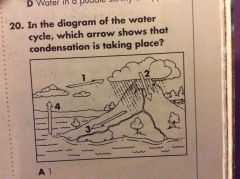![]()
![]()
![]()
Use LEFT and RIGHT arrow keys to navigate between flashcards;
Use UP and DOWN arrow keys to flip the card;
H to show hint;
A reads text to speech;
31 Cards in this Set
- Front
- Back
|
______ is a measure of how salty water is. |
Salinity |
|
|
_____ is the level of the surface of an ocean. |
Sea level |
|
|
A _____ is a lake that forms behind a dam. |
Reservoir |
|
|
_____ forms when raindrops freeze before they hit the ground |
Sleet |
|
|
The layer of rock and soil that groundwater flow through is a(n) _____ |
Aquifer |
|
|
The _____ is the top level of groundwater in an aquifer. |
Water table |
|
|
The area from which water drains into a river is called the river's _____. |
Watershed |
|
|
The repeated movement of water through the environment is the _____. |
Water cycle |
|
|
Describe the ocean and explain how the water cycle effects the salinity of the ocean. |
The more evaporation, the more salt. The less evaporation, the less salt. |
|
|
Explain how clouds usually form rain over the United States. |
Water vapor grabs on to dust and salt to form crystals that soon fall and melt to make it rain. |
|
|
Summarize the roles of evaporation, sublimation, and condensation in the water cycle |
Evaporation - liquid – vapor Condensation – gas – liquid Sublimation – solid – vapor |
|
|
Make a graphic organizer to show how water changes form and moves around Earth in the water cycle |

Back (Definition) |
|
|
The repeated movement of water through the environment is the _____. |
Water cycle |
|
|
Describe the ocean and explain how the water cycle effects the salinity of the ocean. |
The more evaporation, the more salt. The less evaporation, the less salt. |
|
|
Explain how clouds usually form rain over the United States. |
Water vapor grabs on to dust and salt to form crystals that soon fall and melt to make it rain. |
|
|
Summarize the roles of evaporation, sublimation, and condensation in the water cycle |
Evaporation - liquid – vapor Condensation – gas – liquid Sublimation – solid – vapor |
|
|
Make a graphic organizer to show how water changes form and moves around Earth in the water cycle |

Back (Definition) |
|
|
What is one way you can conserve water?
A. Take long showers B. Dig wells C. Fix leaky faucets D. Swim in the ocean |
C. Fix leaky faucets |
|
|
Which kind of cloud touches the ground?
A. Altocumulus B. Fog C. Cirrus D. Lenticular |
B. Fog |
|
|
Where is most of Earth's water located?
A. Rivers B. Groundwater C. Oceans D. Lakes |
C. Oceans |
|
|
Warm water is moved from the Caribbean Sea to the North Atlantic Ocean by
A. An ocean current B. The water cycle C. The water table D. An aquifer |
A. An ocean current |
|
|
What is the process that changes water vapor into clouds or fog?
A. Evaporation B. Sublimation C. Condensation D. Runoff |
C. Condensation |
|
|
Which of the following is an example of evaporation?
A. Water on land sinks into soil B. A layer of ice forms on a puddle C. Rain falls from a cloud D. Water in a puddle slowly disappears |
D. Water in a puddle slowly disappears |
|

A. 1 B. 2 C. 3 D. 4 |
A. 1 |
|
|
Know how clouds form and the four different types. |
Clouds form when water vapor condenses to form a tiny water droplets. The four types of clouds are Cirrus clouds, thunderheads, altocumulus clouds, stratus clouds, and fog. |
|
|
No the characteristics of the ocean and freshwater. |
Almost all hydrosphere is ocean. Oceans get salty from rivers Glaciers or ice |
|
|
No the water cycle and where it gets energy. |
Water evaporates, then condenses, then precipitates. The water cycle gets its energy from the sun. |
|
|
No the water cycle and where it gets energy. |
Water evaporates, then condenses, then precipitates. The water cycle gets its energy from the sun. |
|
|
Know what recycling does for our water supply |
It helps to save water |
|
|
Know about aqueducts |
And aqueduct is a system of pipes that carries water from a river or lake to the area it's needed. Southern California uses an aqueduct system from the Sacramento River. San Diego uses water from the Colorado River. |
|
|
No the different types of precipitation |
Rain, freezing rain, sleet, and snow |

